Rockfall Analysis from UAV-Based Photogrammetry and 3D Models of a Cliff Area
Abstract
1. Introduction
1.1. Study Area
1.2. Geological Settings
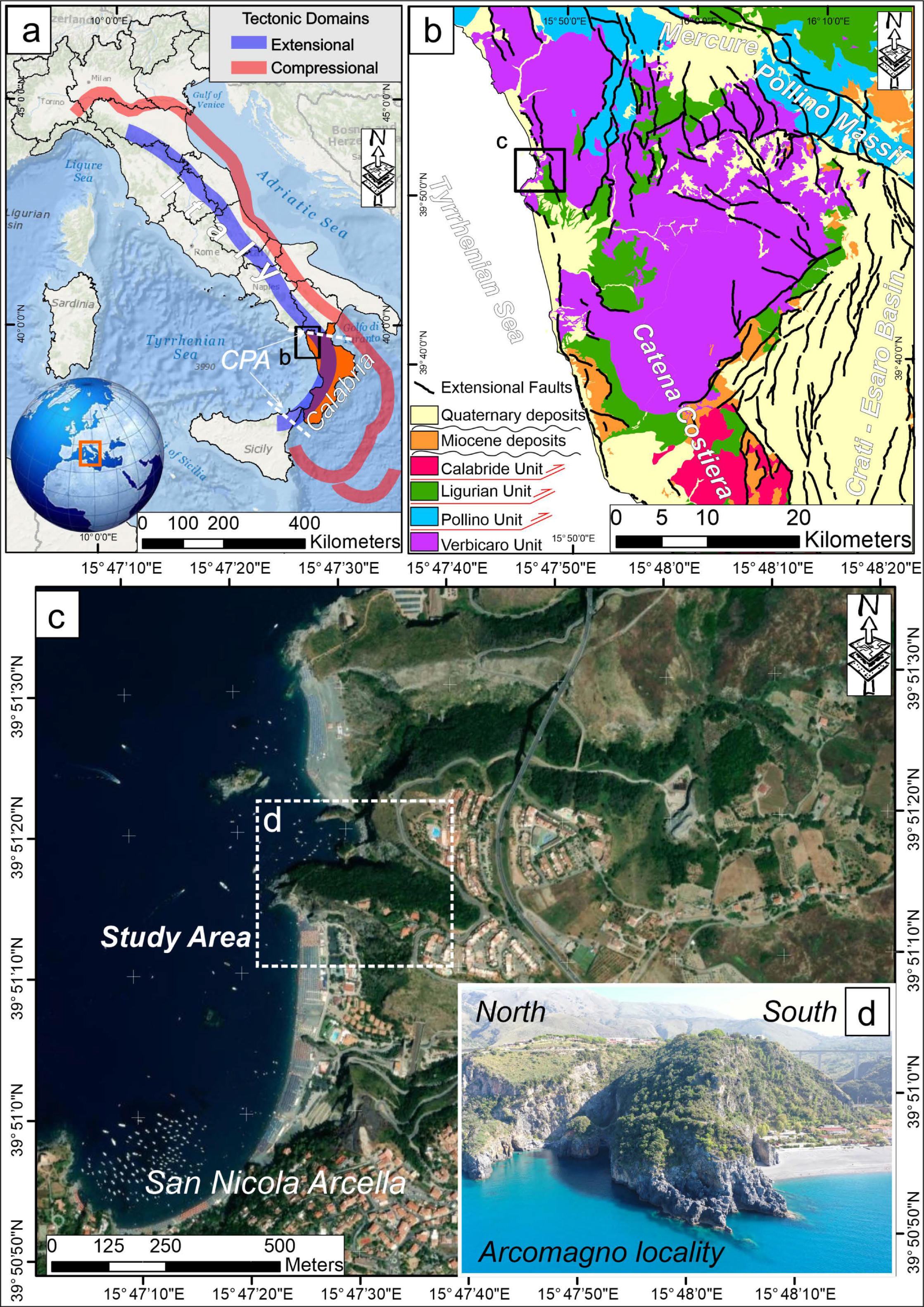
2. Materials and Methods
2.1. UAV Photogrammetric Survey Data
2.2. Photogrammetric Data Processing
2.3. Fracturing Data Extraction
2.4. Kinematic Analysis
2.5. Jointing Frequency Analysis
3. Results
3.1. High-Resolution DTM Analysis
- (i)
- Shaded Relief (Figure 9a): This map was crucial in identifying several geomorphological elements essential for determining and delineating the 10 investigated areas. Indeed, the map shows the presence of various beach zones, variable in size, situated at the foot of some cliffs. The topographic differences are also evident in this DTM, and the pathways accessing different coves and pocket beaches are evident. Furthermore, on the map, a large parking area is observable at the base of the steeper cliff in Area 1 (Figure 6). Additionally, a clearly defined incised valley is noticeable in the central area, flowing directly into Arcomagno Beach, one of the most renowned beaches in the studied area.
- (ii)
- Digital Terrain Model (Figure 9b): This DTM analysis provided information on the elevation of each point of the studied area from sea level. Therefore, the maximum ground elevation within the study area was 120 m above sea level; instead, the analysed rock scarps reached elevations ranging between 20 and 120 m a.s.l. In particular, referring to Figure 6, Areas 1 and 3, with the cliff face strike oriented in the NW-SE direction, feature the highest rock faces, reaching heights exceeding 100 m. Areas 9 and 10, oriented NW-SE and E-W, respectively, have rock faces that reach heights of around 80 m. Conversely, areas 2, 4, 5, 6, 7, and 8 have shorter rock faces, with heights ranging from 20 to 60 m and slope orientations varying from N-S to E-W.
- (iii)
- Slope Degree (Figure 9c): This DTM allowed slope degree representation by measuring the angle between the ground surface and the horizontal plane. The highlights obtained by this DTM show that most of the analysed rock scarps fall in areas facing the sea and are characterised by slope degree values ranging between 70° and 90°. All studied areas were selected because they exhibit slopes with inclinations exceeding 40 degrees, and in most cases, these slopes surpass 70–80 degrees, forming vertical or overhanging rock faces (Figure 9c).
- (iv)
- Slope Exposure (Figure 9d): The analysis revealed the slope direction concerning the cardinal points (north, south, east, and west), showing that the examined surfaces predominantly orient towards the northern quadrants, followed by slopes facing the southern quadrants.
3.2. Analyses of Planar Facets
3.3. Jointing Grade
4. Discussion
5. Concluding Comments
Author Contributions
Funding
Data Availability Statement
Acknowledgments
Conflicts of Interest
References
- Guzzetti, F. Landslide fatalities and the evaluation of landslide risk in Italy. Eng. Geol. 2000, 58, 89–107. [Google Scholar] [CrossRef]
- Ietto, F.; Conforti, M.; Tolomei, C.; Cianflone, G. Village relocation as solution of the landslide risk, is it always the right choice? The case study of Cavallerizzo ghost village (Calabria, southern Italy). Int. J. Disaster Risk Reduct. 2022, 81, 103267. [Google Scholar] [CrossRef]
- Stead, D.; Wolter, A. A critical review of rock slope failure mechanisms: The importance of structural geology. J. Struct. Geol. 2015, 74, 1–23. [Google Scholar] [CrossRef]
- Sun, L.; Grasselli, G.; Liu, Q.; Tang, X.; Abdelaziz, A. The role of discontinuities in rock slope stability: Insights from a combined finite-discrete element simulation. Comput. Geotechnics 2022, 147, 104788. [Google Scholar] [CrossRef]
- Stead, D.; Eberhardt, E.; Coggan, J.S. Developments in the characterization of complex rock slope deformation and failure using numerical modelling techniques. Eng. Geol. 2006, 83, 217–235. [Google Scholar] [CrossRef]
- Eberhardt, E. Twenty-ninth Canadian Geotechnical Colloquium: The role of advanced numerical methods and geotechnical field measurements in understanding complex deep-seated rock slope failure mechanisms. Can. Geotech. J. 2008, 45, 484–510. [Google Scholar] [CrossRef]
- Calcaterra, D.; Parise, M. Weathering as a predisposing factor to slope movements: An introduction. Eng. Geol. Spec. Publ. 2010, 23, 1–4. [Google Scholar] [CrossRef]
- Ietto, F.; Parise, M.; Ponte, M.; Calcaterra, D. Geotechnical characterization and landslides in the weathered granitoids of Calabria (southern Italy). Ren. Online Soc. Geol. Ital. 2012, 2012, 551–552. [Google Scholar]
- Filice, F.; Pezzo, A.; Lollino, P.; Perrotti, M.; Ietto, F. Multi-approach for the assessment of rock slope stability using in-field and UAV investigations. Bull. Eng. Geol. Environ. 2022, 81, 502. [Google Scholar] [CrossRef]
- Varnes, D.J. Slope Movement Types and Processes. In Landslides, Analysis and Control; Schuster, R.L., Ed.; TRB, National Research Council: Washington, DC, USA, 1978; pp. 11–33. [Google Scholar]
- Cruden, D.M.; Varnes, D.J. Landslide types and processes. In Landslides: Investigation and Mitigation; Turner, A.K., Ed.; National Academy Press: Washington, DC, USA, 1996. [Google Scholar]
- Norman, N. Rock Slope Stability Analysis. In Landslides: Investigation and Mitigation; Transportation Research Board: Washington, DC, USA, 1996; Volume 247. [Google Scholar]
- Feng, L.; Pazzi, V.; Intrieri, E.; Gracchi, T.; Gigli, G. Rockfall seismic features analysis based on in situ tests: Frequency, amplitude, and duration. J. Mt. Sci. Engl. 2019, 16, 955–970. [Google Scholar] [CrossRef]
- Matas, G.; Lantada, N.; Corominas, J.; Gili, J.; Ruiz-Carulla, R.; Prades, A. Simulation of Full-Scale Rockfall Tests with a Fragmentation Model. Geosciences 2020, 10, 168. [Google Scholar] [CrossRef]
- Schultz, R.A.; Fossen, H. Terminology for structural discontinuities. AAPG Bull. 2008, 92, 853–867. [Google Scholar] [CrossRef]
- Fossen, H. Structural Geology; Cambridge University Press: Cambridge, UK, 2010; p. 463. [Google Scholar] [CrossRef]
- Turanboy, A.; Ulker, E. LIP-RM: An attempt at 3D visualization of in situ rock mass structures. Comput. Geosci. 2008, 12, 181–192. [Google Scholar] [CrossRef]
- Lee, B.Y.; Kim, Y.Y.; Yi, S.-T.; Kim, J.-K. Automated image processing technique for detecting and analysing concrete surface cracks. Struct. Infrastruct. Eng. 2013, 9, 567–577. [Google Scholar] [CrossRef]
- Assali, P.; Pollet, N. Contribution of Terrestrial Laser Scanning for monitoring and inspection of railway infrastructure. In Proceedings of World Congress on Railway Research, Sydney, Australia, 25–28 November 2013. [Google Scholar]
- Sen, Z.; Kazi, A. Discontinuity Spacing and RQD Estimates from Finite Length Scanlines. Int. J. Rock Mech. Min. Sci. Geomech. 1984, 21, 203–212. [Google Scholar] [CrossRef]
- Nagendran, S.K.; Mohamad Ismail, M.A.; Wen, Y.T. Photogrammetry approach on geological plane extraction using CloudCompare FACET plugin and scanline survey. Bull. Geol. Soc. Malays. 2019, 68, 151–158. [Google Scholar] [CrossRef]
- Mondini, A.; Santangelo, M.; Rocchetti, M.; Rossetto, E.; Manconi, A.; Monserrat, O. Sentinel-1 SAR Amplitude Imagery for Rapid Landslide Detection. Remote Sens. 2019, 11, 760. [Google Scholar] [CrossRef]
- Rott, H.; Nagler, T. The contribution of radar interferometry to the assessment of landslide hazards. Adv. Space Res. Ser. 2006, 37, 710–719. [Google Scholar] [CrossRef]
- Santangelo, M.; Cardinali, M.; Bucci, F.; Fiorucci, F.; Mondini, A.C. Exploring event landslide mapping using Sentinel-1 SAR backscatter products. Geomorphology 2022, 397, 108021. [Google Scholar] [CrossRef]
- Bianchini, S.; Herrera, G.; Mateos, R.M.; Notti, D.; Garcia, I.; Mora, O.; Moretti, S. Landslide Activity Maps Generation by Means of Persistent Scatterer Interferometry. Remote Sens. 2013, 5, 6198–6222. [Google Scholar] [CrossRef]
- Herrera, G.; Gutiérrez, F.; García-Davalillo, J.C.; Guerrero, J.; Notti, D.; Galve, J.P.; Fernández-Merodo, J.A.; Cooksley, G. Multi-sensor advanced DInSAR monitoring of very slow landslides: The Tena Valley case study (Central Spanish Pyrenees). Remote Sens. Environ. 2013, 128, 31–43. [Google Scholar] [CrossRef]
- Solari, L.; Del Soldato, M.; Raspini, F.; Barra, A.; Bianchini, S.; Confuorto, P.; Casagli, N.; Crosetto, M. Review of Satellite Interferometry for Landslide Detection in Italy. Remote Sens. 2020, 12, 1351. [Google Scholar] [CrossRef]
- Brideau, M.A.; Pedrazzini, A.; Stead, D.; Froese, C.; Jaboyedoff, M.; van Zeyl, D. Three-dimensional slope stability analysis of South Peak, Crowsnest Pass, Alberta, Canada. Landslides 2011, 8, 139–158. [Google Scholar] [CrossRef]
- Brideau, M.A.; Sturzenegger, M.; Stead, D.; Jaboyedoff, M.; Lawrence, M.; Roberts, N.; Ward, B.; Millard, T.; Clague, J. Stability analysis of the 2007 Chehalis lake landslide based on long-range terrestrial photogrammetry and airborne LiDAR data. Landslides 2012, 9, 75–91. [Google Scholar] [CrossRef]
- Guzzetti, F.; Reichenbach, P.; Wieczorek, G.F. Rockfall hazard and risk assessment in the Yosemite Valley, California, USA. Nat. Hazards Earth Syst. Sci. 2003, 3, 491–503. [Google Scholar] [CrossRef]
- Strunden, J.; Ehlers, T.A.; Brehm, D.; Nettesheim, M. Spatial and temporal variations in rockfall determined from TLS measurements in a deglaciated valley, Switzerland. J. Geophys. Res. Earth 2015, 120, 1251–1273. [Google Scholar] [CrossRef]
- Jaboyedoff, M.; Oppikofer, T.; Abellán, A.; Derron, M.H.; Loye, A.; Metzger, R.; Pedrazzini, A. Use of LIDAR in landslide investigations: A review. Nat. Hazards 2012, 61, 5–28. [Google Scholar] [CrossRef]
- Xu, Q.; Ye, Z.; Liu, Q.; Dong, X.J.; Li, W.L.; Fang, S.N.; Guo, C. 3D Rock Structure Digital Characterization Using Airborne LiDAR and Unmanned Aerial Vehicle Techniques for Stability Analysis of a Blocky Rock Mass Slope. Remote Sens. 2022, 14, 3044. [Google Scholar] [CrossRef]
- Bemis, S.P.; Micklethwaite, S.; Turner, D.; James, M.R.; Akciz, S.; Thiele, S.; Bangash, H.A. Ground-based and UAV-Based photogrammetry: A multi-scale, high-resolution mapping tool for structural geology and paleoseismology. J. Struct. Geol. 2014, 69, 163–178. [Google Scholar] [CrossRef]
- Berquist, S.; Spence-Morrow, G.; Gonzalez-Macqueen, F.; Rizzuto, B.; Álvarez, W.Y.; Bautista, S.; Jennings, J. A new aerial photogrammetric survey method for recording inaccessible rock art. Digit. Appl. Archaeol. Cult. Herit. 2018, 8, 46–56. [Google Scholar] [CrossRef]
- Bonali, F.L.; Tibaldi, A.; Marchese, F.; Fallati, L.; Russo, E.; Corselli, C.; Savini, A. UAV-based surveying in volcano-tectonics: An example from the Iceland rift. J. Struct. Geol. 2019, 121, 46–64. [Google Scholar] [CrossRef]
- Cawood, A.J.; Bond, C.E.; Howell, J.A.; Butler, R.W.H.; Totake, Y. LiDAR, UAV or compass-clinometer? Accuracy, coverage and the effects on structural models. J. Struct. Geol. 2017, 98, 67–82. [Google Scholar] [CrossRef]
- Cirillo, D. Digital Field Mapping and Drone-Aided Survey for Structural Geological Data Collection and Seismic Hazard Assessment: Case of the 2016 Central Italy Earthquakes. Appl. Sci. 2020, 10, 5233. [Google Scholar] [CrossRef]
- Menichetti, M.; Roccheggiani, M.; De Guidi, G.; Carnemolla, F.; Brighenti, F.; Barreca, G.; Monaco, C. Sentinel-1 Interferometry and UAV Aerial Survey for Mapping Coseismic Ruptures: Mts. Sibillini vs. Mt. Etna Volcano. Remote Sens. 2023, 15, 2514. [Google Scholar] [CrossRef]
- Tavani, S.; Corradetti, A.; Billi, A. High precision analysis of an embryonic extensional fault-related fold using 3D orthorectified virtual outcrops: The viewpoint importance in structural geology. J. Struct. Geol. 2016, 86, 200–210. [Google Scholar] [CrossRef]
- Vanneschi, C.; Rindinella, A.; Salvini, R. Hazard Assessment of Rocky Slopes: An Integrated Photogrammetry–GIS Approach Including Fracture Density and Probability of Failure Data. Remote Sens. 2022, 14, 1438. [Google Scholar] [CrossRef]
- Vanneschi, C.; Di Camillo, M.; Aiello, E.; Bonciani, F.; Salvini, R. SfM-MVS Photogrammetry for Rockfall Analysis and Hazard Assessment Along the Ancient Roman Via Flaminia Road at the Furlo Gorge (Italy). ISPRS Int. J. Geo-Inf. 2019, 8, 325. [Google Scholar] [CrossRef]
- De Donatis, M.; Alberti, M.; Cipicchia, M.; Guerrero, N.M.; Pappafico, G.F.; Susini, S. Workflow of Digital Field Mapping and Drone-Aided Survey for the Identification and Characterization of Capable Faults: The Case of a Normal Fault System in the Monte Nerone Area (Northern Apennines, Italy). ISPRS Int. J. Geo-Inf. 2020, 9, 616. [Google Scholar] [CrossRef]
- Bello, S.; Scott, C.P.; Ferrarini, F.; Brozzetti, F.; Scott, T.; Cirillo, D.; de Nardis, R.; Arrowsmith, J.R.; Lavecchia, G. High-resolution surface faulting from the 1983 Idaho Lost River Fault Mw 6.9 earthquake and previous events. Sci. Data 2021, 8, 68. [Google Scholar] [CrossRef]
- Johnson, K.; Nissen, E.; Saripalli, S.; Arrowsmith, J.R.; McGarey, P.; Scharer, K.; Williams, P.; Blisniuk, K. Rapid mapping of ultrafine fault zone topography with structure from motion. Geosphere 2014, 10, 969–986. [Google Scholar] [CrossRef]
- Westoby, M.J.; Brasington, J.; Glasser, N.F.; Hambrey, M.J.; Reynolds, J.M. ‘Structure-from-Motion’ photogrammetry: A low-cost, effective tool for geoscience applications. Geomorphology 2012, 179, 300–314. [Google Scholar] [CrossRef]
- Jacquemyn, C.; Huysmans, M.; Hunt, D.; Casini, G.; Swennen, R. Multi-scale three-dimensional distribution of fracture- and igneous intrusion- controlled hydrothermal dolomite from digital outcrop model, Latemar platform, Dolomites, northern Italy. AAPG Bull. 2015, 99, 957–984. [Google Scholar] [CrossRef]
- Loiotine, L.; Andriani, G.F.; Jaboyedoff, M.; Parise, M.; Derron, M.-H. Comparison of Remote Sensing Techniques for Geostructural Analysis and Cliff Monitoring in Coastal Areas of High Tourist Attraction: The Case Study of Polignano a Mare (Southern Italy). Remote Sens. 2021, 13, 5045. [Google Scholar] [CrossRef]
- Caliò, D.; Mineo, S.; Pappalardo, G. Digital Rock Mass Analysis for the Evaluation of Rockfall Magnitude at Poorly Accessible Cliffs. Remote Sens. 2023, 15, 1515. [Google Scholar] [CrossRef]
- Bistacchi, A.; Balsamo, F.; Storti, F.; Mozafari, M.; Swennen, R.; Solum, J.; Tueckmantel, C.; Taberner, C. Photogrammetric digital outcrop reconstruction, visualization with textured surfaces, and three-dimensional structural analysis and modeling: Innovative methodologies applied to fault-related dolomitization (Vajont Limestone, Southern Alps, Italy). Geosphere 2015, 11, 2031–2048. [Google Scholar] [CrossRef]
- James, M.R.; Robson, S. Straightforward reconstruction of 3D surfaces and topography with a camera: Accuracy and geoscience application. J. Geophys. Res. Earth Surf. 2012, 117, 1–17. [Google Scholar] [CrossRef]
- Thiele, S.T.; Grose, L.; Samsu, A.; Micklethwaite, S.; Vollgger, S.A.; Cruden, A.R. Rapid, semi-automatic fracture and contact mapping for point clouds, images and geophysical data. Solid Earth 2017, 8, 1241–1253. [Google Scholar] [CrossRef]
- Barlow, J.; Gilham, J.; Ibarra Cofrã, I. Kinematic analysis of sea cliff stability using UAV photogrammetry. Int. J. Remote Sens. 2017, 38, 2464–2479. [Google Scholar] [CrossRef]
- Vollgger, S.A.; Cruden, A.R. Mapping folds and fractures in basement and cover rocks using UAV photogrammetry, Cape Liptrap and Cape Paterson, Victoria, Australia. J. Struct. Geol. 2016, 85, 168–187. [Google Scholar] [CrossRef]
- Francioni, M.; Antonaci, F.; Sciarra, N.; Robiati, C.; Coggan, J.; Stead, D.; Calamita, F. Application of Unmanned Aerial Vehicle Data and Discrete Fracture Network Models for Improved Rockfall Simulations. Remote Sens. 2020, 12, 2053. [Google Scholar] [CrossRef]
- Gallo, I.G.; Martínez-Corbella, M.; Sarro, R.; Iovine, G.; López-Vinielles, J.; Hérnandez, M.; Robustelli, G.; Mateos, R.M.; García-Davalillo, J.C. An Integration of UAV-Based Photogrammetry and 3D Modelling for Rockfall Hazard Assessment: The Cárcavos Case in 2018 (Spain). Remote Sens. 2021, 13, 3450. [Google Scholar] [CrossRef]
- Wang, W.; Zhao, W.; Chai, B.; Du, J.; Tang, L.; Yi, X. Discontinuity interpretation and identification of potential rockfalls for high-steep slopes based on UAV nap-of-the-object photogrammetry. Comput. Geosci. 2022, 166, 105191. [Google Scholar] [CrossRef]
- Ferrari, E.; Coscarelli, R.; Buttafuoco, G.; Caloiero, T. Spatial and temporal characterization of climate at regional scale using homogeneous monthly precipitation and air temperature data: An application in Calabria (southern Italy). Hydrol. Res. 2015, 46, 629–646. [Google Scholar] [CrossRef]
- Tangari, A.C.; Le Pera, E.; Andò, S.; Garzanti, E.; Piluso, E.; Marinangeli, L.; Scarciglia, F. Soil-formation in the central Mediterranean: Insight from heavy minerals. Catena 2021, 197, 104998. [Google Scholar] [CrossRef]
- Petrucci, O.; Chiodo, G.; Caloiero, D. Eventi Alluvionali in Calabria nel Decennio 1971–1980; GNDCI, Rubbettino Arti Grafiche; Soveria Mannelli: Catanzaro, Italy, 1996; p. 142. (In Italian) [Google Scholar]
- Robustelli, G.; Muto, F.; Scarciglia, F.; Spina, V.; Critelli, S. Eustatic and tectonic control on Late Quaternary alluvial fans along the Tyrrhenian Sea coast of Calabria (South Italy). Quat. Sci. Rev. 2005, 24, 2101–2119. [Google Scholar] [CrossRef]
- Perri, F.; Ietto, F. Flash flood event (October 2010) in the Zinzolo catchment (Calabria, southern Italy). Rend. Online Della Soc. Geol. Ital. 2015, 35, 170–173. [Google Scholar] [CrossRef]
- Medina, S.; Bradley, F.S.; Robert, A.; Houze, J. Cross-Barrier Flow during Orographic Precipitation Events: Results from MAP and IMPROVE. J. Atmos. Sci. 2005, 62, 3580–3598. [Google Scholar] [CrossRef][Green Version]
- Minzoni, N. The Geodynamic Evolution of the Sardinian-Corsican and Calabrian-Peloritan Hercynian Massifs. In Proceedings of the International Conferences on Basement Tectonics; Springer: Dordrecht, The Netherlands, 1995. [Google Scholar]
- Scandone, P. Origin of the Tyrrhenian Sea and Calabrian Arc. Boll. Della Soc. Geol. Ital. 1979, 98, 27–34. [Google Scholar]
- Ben Avraham, Z.; Boccaletti, M.; Cello, G.; Grasso, M.; Lentini, F.; Torelli, L.; Tortorici, L. Principali domini strutturali originatisi dalla collisione neogenico-quaternaria nel Mediterraneo centrale. Mem. Soc. Geol. It. 1990, 45, 453–462. [Google Scholar]
- Jolivet, L.; Faccenna, C. Mediterranean extension and the Africa-Eurasia collision. Tectonics 2000, 19, 1095–1106. [Google Scholar] [CrossRef]
- Catalano, S.; Cirrincione, R.; Mazzoleni, P.; Pavano, F.; Pezzino, A.; Romagnoli, G.; Tortorici, G. The effects of a Meso-Alpine collision event on the tectono-metamorphic evolution of the Peloritani mountain belt (eastern Sicily, southern Italy). Geol. Mag. 2018, 155, 422–437. [Google Scholar] [CrossRef]
- Ogniben, L. Schema geologico della Calabria in base ai dati odierni. Geol. Romana 1973, 12, 243–585. [Google Scholar]
- Monaco, C.; Tortorici, L. Active faulting in the Calabrian arc and eastern Sicily. J. Geodyn. 2000, 29, 407–424. [Google Scholar] [CrossRef]
- Brutto, F.; Muto, F.; Loreto, M.F.; Paola, N.D.; Tripodi, V.; Critelli, S.; Facchin, L. The Neogene-Quaternary geodynamic evolution of the central Calabrian Arc: A case study from the western Catanzaro Trough basin. J. Geodyn. 2016, 102, 95–114. [Google Scholar] [CrossRef]
- Pirrotta, C.; Barberi, G.; Barreca, G.; Brighenti, F.; Carnemolla, F.; De Guidi, G.; Monaco, C.; Pepe, F.; Scarfì, L. Recent Activity and Kinematics of the Bounding Faults of the Catanzaro Trough (Central Calabria, Italy): New Morphotectonic, Geodetic and Seismological Data. Geosciences 2021, 11, 405. [Google Scholar] [CrossRef]
- Iannace, A.; Bonardi, G.; D’Errico, M.; Mazzoli, S.; Perrone, V.; Vitale, S. Structural setting and tectonic evolution of the Apennine Units of northern Calabria. Comptes Rendus Geosci. 2005, 337, 1541–1550. [Google Scholar] [CrossRef]
- Iannace, A.; Vitale, S.; D’Errico, M.; Mazzoli, S.; Di Staso, A.; Macaione, E.; Messina, A.; Reddy, S.M.; Somma, R.; Zamparelli, V.; et al. The carbonate tectonic units of northern Calabria (Italy): A record of Apulian palaeomargin evolution and Miocene convergence, continental crust subduction, and exhumation of HP–LT rocks. J. Geol. Soc. 2007, 164, 1165–1186. [Google Scholar] [CrossRef]
- Rossetti, F.; Goffé, B.; Monié, P.; Faccenna, C.; Vignaroli, G. Alpine orogenic P-T-t-deformation history of the Catena Costiera area and surrounding regions (Calabrian Arc, southern Italy): The nappe edifice of north Calabria revised with insights on the Tyrrhenian-Apennine system formation: Alpine tectonics in north Calabria. Tectonics 2004, 23, 1–26. [Google Scholar] [CrossRef]
- Patacca, E.; Scandone, P. Geology of the Southern Apennines. Int. J. Geosci. 2007, 5, 75–119. [Google Scholar]
- Ghisetti, F.; Vezzani, L. Structural Map of Mt. Pollino (Southern Italy); 1:50,000; SELCA: Firenze, Italy, 1983. [Google Scholar]
- Ietto, A.; Ietto, F. Note Illustrative Della Carta Geologica D’Italia Alla Scala 1:50.000, Foglio 542, Verbicaro. Litografia Artistica Cartografica, Firenze.: Servizio Geologico d’Italia. 2011. Available online: http://www.isprambiente.gov.it/Media/carg/note_illustrative/542_Verbicaro.pdf (accessed on 17 January 2024).
- Ogniben, L. Schema introduttivo alla geologia del confine Calabro-Lucano. Mem. Soc. Geol. It. 1969, 8, 453–763. [Google Scholar]
- Amodio, M.L.; Bonardi, G.; Colonna, V.; Dietrich, D.; Giunta, G.; Ippolito, F.; Liguori, V.; Lorenzoni, F.; Paglionico, A.; Perrone, V.; et al. L’arco calabro-peloritano nell’orogene appenninico-maghrebide Translated Title: The Calabro-Peloritani Arc during the Apennine-Maghrebide Orogeny. Atti del 68esimo Congresso della Societa Geologica Italiana; l’Arco calabro-peloritano nell’orogene appenninico-maghrebide. Mem. Soc. Geol. It. 1976, 17, 1–60. [Google Scholar]
- Liberi, F.; Morten, L.; Piluso, E. Geodynamic significance of ophiolites within the Calabrian Arc. Isl. Arc 2006, 15, 26–43. [Google Scholar] [CrossRef]
- Filice, F.; Liberi, F.; Cirillo, D.; Pandolfi, L.; Marroni, M.; Piluso, E. Geology map of the central area of Catena Costiera: Insights into the tectono-metamorphic evolution of the Alpine belt in Northern Calabria. J. Maps 2015, 11, 114–125. [Google Scholar] [CrossRef]
- Climaco, A.; Boni, M.; Iannace, A.; Zamparelli, V. Platform margins, microbial/serpulids bioconstructions and slope-to-basin sediments in the Upper Triassic of the ‘Verbicaro Unit’ (Lucania and Calabria, southern Italy). Facies 1997, 36, 37–56. [Google Scholar] [CrossRef]
- Ghisetti, F.; Vezzani, L. Strutture tensionali e compressive indotte da meccanismi protondi lungo la linea del Pollino (Appennino meridionale). Boll. Della Soc. Geol. Ital. 1982, 101, 385–440. [Google Scholar]
- Iannace, A.; Vitale, S. The value of the old scientific literature: A lesson from the Calabria-Lucania border geology. Rend. Online Della Soc. Geol. Ital. 2013, 25, 68–77. [Google Scholar] [CrossRef]
- Vezzani, L.; Festa, A.; Ghisetti, F.C. Geology and Tectonic Evolution of the Central-Southern Apennines, Italy. In Geology and Tectonic Evolution of the Central-Southern Apennines, Italy; Geological Society of America: Washington, DC, USA, 2010. [Google Scholar]
- Tangari, A.C.; Scarciglia, F.; Piluso, E.; Marinangeli, L.; Pompilio, L. Role of weathering of pillow basalt, pyroclastic input and geomorphic processes on the genesis of the Monte Cerviero upland soils (Calabria, Italy). Catena 2018, 171, 299–315. [Google Scholar] [CrossRef]
- Liberi, F.; Piluso, E. Tectonometamorphic evolution of the ophiolitic sequencesfrom Northern Calabrian Arc. Ital. J. Geosci. 2009, 128, 483–493. [Google Scholar] [CrossRef]
- Graessner, T.; Schenk, V. Low-pressure metamorphism of Palaeozoic pelites in the Aspromonte, southern Calabria: Constraints for the thermal evolution in the Calabrian cross-section during the Hercynian orogeny. J. Metamorph. Geol. 1999, 17, 157–172. [Google Scholar] [CrossRef]
- Piluso, E.; Cirrincione, R.; Morten, L. Ophiolites of tha Calabrian Peloritan Arc and their relationiship with the crystalline basement (Catena Costiera and Sila Piccola, Calabria, Southern Italy) Glom 2000 Excursion Guide-Book. Ofioliti 2000, 25, 117–140. [Google Scholar]
- Piluso, E.; Morten, L. Hercynian high temperature granulites and migmatites from the Catena Costiera, northern Calabria, southern Italy. Per. Mineral. 2004, 73, 159–172. [Google Scholar]
- Cifelli, F.; Rossetti, F.; Mattei, M. The architecture of brittle postorogenic extension: Results from an integrated structural and paleomagnetic study in north Calabria (southern Italy). Geol. Soc. Am. Bull. 2007, 119, 221–239. [Google Scholar] [CrossRef]
- Mattei, M.; Cipollari, P.; Cosentino, D.; Argentieri, A.; Rossetti, F.; Speranza, F.; Di Bella, L. The Miocene tectono-sedimentary evolution of the southern Tyrrhenian Sea: Stratigraphy, structural and palaeomagnetic data from the on-shore Amantea basin (Calabrian Arc, Italy): Tectono-sedimentary evolution of the Amantea basin. Basin Res. 2002, 14, 147–168. [Google Scholar] [CrossRef]
- Brozzetti, F.; Cirillo, D.; Liberi, F.; Piluso, E.; Faraca, E.; De Nardis, R.; Lavecchia, G. Structural style of Quaternary extension in the Crati Valley (Calabrian Arc): Evidence in support of an east-dipping detachment fault. Ital. J. Geosci. 2017, 136, 434–453. [Google Scholar] [CrossRef]
- Cirillo, D.; Totaro, C.; Lavecchia, G.; Orecchio, B.; de Nardis, R.; Presti, D.; Ferrarini, F.; Bello, S.; Brozzetti, F. Structural complexities and tectonic barriers controlling recent seismic activity in the Pollino area (Calabria–Lucania, southern Italy)—constraints from stress inversion and 3D fault model building. Solid Earth 2022, 13, 205–228. [Google Scholar] [CrossRef]
- Ercoli, M.; Cirillo, D.; Pauselli, C.; Jol, H.M.; Brozzetti, F. Ground-penetrating radar signature of Quaternary faulting: A study from the Mt. Pollino region, southern Apennines, Italy. Solid Earth 2021, 12, 2573–2596. [Google Scholar] [CrossRef]
- Filice, F.; Seeber, L. The Culmination of an Oblique Time-Transgressive Arc Continent Collision: The Pollino Massif Between Calabria and the Southern Apennines, Italy. Tectonics 2019, 38, 3261–3280. [Google Scholar] [CrossRef]
- Robustelli, G.; Ermolli, E.R.; Petrosino, P.; Jicha, B.; Sardella, R.; Donato, P. Tectonic and climatic control on geomorphological and sedimentary evolution of the Mercure basin, southern Apennines, Italy. Geomorphology 2014, 214, 423–435. [Google Scholar] [CrossRef]
- Robustelli, G.; Muto, F. The Crati River Basin: Geomorphological and stratigraphical data for the Plio–Quaternary evolution of northern Calabria, South Apennines, Italy. Geol. Carpathica 2017, 68, 68–79. [Google Scholar] [CrossRef]
- Borrelli, L.; Perri, F.; Critelli, S.; Gullà, G. Minero-petrographical features of weathering profiles in Calabria, southern Italy. Catena 2012, 92, 196–207. [Google Scholar] [CrossRef]
- Borrelli, L.; Greco, R.; Gullà, G. Weathering grade of rock masses as a predisposing factor to slope instabilities: Reconnaissance and control procedures. Geomorphology 2007, 87, 158–175. [Google Scholar] [CrossRef]
- Ietto, F.; Perri, F.; Miriello, D.; Ruffolo, S.A.; Laganà, A.; Le Pera, E. Epoxy Resin for the Slope Consolidation Intervention on the Tropea Sandstone Cliff (Southern Calabria, Italy). Geoheritage 2018, 10, 287–300. [Google Scholar] [CrossRef]
- Ghisetti, F.; Vezzani, L. The geodynamic evolution of the crustal structures of Calabria and Sicily. Boll. Geod. Sci. Aff. 1979, 44, 411–437. [Google Scholar]
- Ghisetti, F.; Vezzani, L. Contribution of structural analysis to understanding the geodynamic evolution of the Calabrian arc (Southern Italy). J. Struct. Geol. 1981, 3, 371–381. [Google Scholar] [CrossRef]
- Brogan, G.E.; Cluff, L.S.; Taylor, C.L. Seismicity and uplift of southern Italy. Tectonophysics 1975, 29, 323–330. [Google Scholar] [CrossRef]
- Bello, S.; de Nardis, R.; Scarpa, R.; Brozzetti, F.; Cirillo, D.; Ferrarini, F.; di Lieto, B.; Arrowsmith, J.R.; Lavecchia, G. Fault Pattern and Seismotectonic Style of the Campania—Lucania 1980 Earthquake (Mw 6.9, Southern Italy): New Multidisciplinary Constraints. Front. Earth Sci. 2021, 8, 63. [Google Scholar] [CrossRef]
- Bello, S.; Lavecchia, G.; Andrenacci, C.; Ercoli, M.; Cirillo, D.; Carboni, F.; Barchi, M.R.; Brozzetti, F. Complex trans-ridge normal faults controlling large earthquakes. Sci. Rep. 2022, 12, 10676. [Google Scholar] [CrossRef]
- Brozzetti, F.; Mondini, A.C.; Pauselli, C.; Mancinelli, P.; Cirillo, D.; Guzzetti, F.; Lavecchia, G. Mainshock Anticipated by Intra-Sequence Ground Deformations: Insights from Multiscale Field and SAR Interferometric Measurements. Geosciences 2020, 10, 186. [Google Scholar] [CrossRef]
- Lavecchia, G.; Bello, S.; Andrenacci, C.; Cirillo, D.; Ferrarini, F.; Vicentini, N.; de Nardis, R.; Roberts, G.; Brozzetti, F. QUaternary fault strain INdicators database—QUIN 1.0—First release from the Apennines of central Italy. Sci. Data 2022, 9, 204. [Google Scholar] [CrossRef]
- Lavecchia, G.; de Nardis, R.; Ferrarini, F.; Cirillo, D.; Bello, S.; Brozzetti, F. Regional seismotectonic zonation of hydrocarbon fields in active thrust belts: A case study from Italy. In Building Knowledge for Geohazard Assessment and Management in the Caucasus and other Orogenic Regions; Bonali, F.L., Mariotto, F.P., Tsereteli, N., Eds.; Springer: Amsterdam, The Netherlands, 2021; pp. 89–128. [Google Scholar]
- Napolitano, F.; Amoroso, O.; La Rocca, M.; Gervasi, A.; Gabrielli, S.; Capuano, P. Crustal Structure of the Seismogenic Volume of the 2010–2014 Pollino (Italy) Seismic Sequence From 3D P- and S-Wave Tomographic Images. Front. Earth Sci. 2021, 9, 735340. [Google Scholar] [CrossRef]
- Boncio, P.; Auciello, E.; Amato, V.; Aucelli, P.; Petrosino, P.; Tangari, A.C.; Jicha, B.R. Late Quaternary faulting in the southern Matese (Italy): Implications for earthquake potential and slip rate variability in the southern Apennines. Solid Earth 2022, 13, 553–582. [Google Scholar] [CrossRef]
- Critelli, S.; Muto, F.; Tripodi, V.; Perri, F. Link between thrust tectonics and sedimentation processes of stratigraphic sequences from the southern Apennines foreland basin system, Italy. Rend. Online Della Soc. Geol. Ital. 2013, 25, 21–42. [Google Scholar] [CrossRef]
- Ietto, F.; Bernasconi, M.P. The cliff bordering the northwestern margin of the Mesima basin (southern Calabria) is of Pleistocene age. Geogr. Fis. Dinam. Quarter. 2005, 28, 205–210. [Google Scholar]
- Tortorici, L.; Monaco, C.; Tansi, C.; Cocina, O. Recent and active tectonics in the Calabrian arc (Southern Italy). Tectonophysics 1995, 243, 37–55. [Google Scholar] [CrossRef]
- Dinkov, D.; Kitev, A. Advantages, disadvantages and applicability of gnss Post-Processing Kinematic (PPK) method for direct georeferencing of UAV images. In Proceedings of 8th International Conference on Cartography and GIS, 2020, Nessebar, Bulgaria; Bulgarian Cartographic Association: Nessebar, Bulgaria, 2020. [Google Scholar]
- Dinkov, D. A Low Cost Method UAV-PPK—Accuracy and Application. In Proceedings of XXIX International Symposium on Modern Technologies, Education and Professional Practice in Geodesy and Related Fields, Istanbul, Turkey, 5–6 November 2019. [Google Scholar]
- Cirillo, D.; Cerritelli, F.; Agostini, S.; Bello, S.; Lavecchia, G.; Brozzetti, F. Integrating Post-Processing Kinematic (PPK)–Structure-from-Motion (SfM) with Unmanned Aerial Vehicle (UAV) Photogrammetry and Digital Field Mapping for Structural Geological Analysis. ISPRS Int. J. Geo-Inf. 2022, 11, 437. [Google Scholar] [CrossRef]
- Žabota, B.; Kobal, M. Accuracy Assessment of UAV-Photogrammetric-Derived Products Using PPK and GCPs in Challenging Terrains: In Search of Optimized Rockfall Mapping. Remote Sens. 2021, 13, 3812. [Google Scholar] [CrossRef]
- Iizuka, K.; Ogura, T.; Akiyama, Y.; Yamauchi, H.; Hashimoto, T.; Yamada, Y. Improving the 3D model accuracy with a post-processing kinematic (PPK) method for UAS surveys. Geocarto. Int. 2022, 37, 4234–4254. [Google Scholar] [CrossRef]
- Famiglietti, N.A.; Cecere, G.; Grasso, C.; Memmolo, A.; Vicari, A. A Test on the Potential of a Low Cost Unmanned Aerial Vehicle RTK/PPK Solution for Precision Positioning. Sensors 2021, 21, 3882. [Google Scholar] [CrossRef]
- Tomaštík, J.; Mokroš, M.; Surový, P.; Grznárová, A.; Merganič, J. UAV RTK/PPK Method—An Optimal Solution for Mapping Inaccessible Forested Areas? Remote Sens. 2019, 11, 721. [Google Scholar] [CrossRef]
- Kovanic, L.; Blistan, P.; Rozlozník, M.; Szabó, G. UAS RTK/PPK photogrammetry as a tool for mapping the urbanized landscape, creating thematic maps, situation plans and DEM. Acta Montan. Slovaca 2021, 26, 649–660. [Google Scholar] [CrossRef]
- Martínez-Carricondo, P.; Agüera-Vega, F.; Carvajal-Ramírez, F. Accuracy assessment of RTK/PPK UAV-photogrammetry projects using differential corrections from multiple GNSS fixed base stations. Geocarto Int. 2023, 38, 2197507. [Google Scholar] [CrossRef]
- Lucieer, A.; Jong, S.M.d.; Turner, D. Mapping landslide displacements using Structure from Motion (SfM) and image correlation of multi-temporal UAV photography. Prog. Phys. Geogr. Earth Environ. 2013, 38, 97–116. [Google Scholar] [CrossRef]
- Taddia, Y.; Stecchi, F.; Pellegrinelli, A. Coastal Mapping Using DJI Phantom 4 RTK in Post-Processing Kinematic Mode. Drones 2020, 4, 9. [Google Scholar] [CrossRef]
- Štroner, M.; Urban, R.; Seidl, J.; Reindl, T.; Brouček, J. Photogrammetry Using UAV-Mounted GNSS RTK: Georeferencing Strategies without GCPs. Remote Sens. 2021, 13, 1336. [Google Scholar] [CrossRef]
- Zhang, H.; Aldana-Jague, E.; Clapuyt, F.; Wilken, F.; Vanacker, V.; Van Oost, K. Evaluating the potential of post-processing kinematic (PPK) georeferencing for UAV-based structure- from-motion (SfM) photogrammetry and surface change detection. Earth Surf. Dyn. 2019, 7, 807–827. [Google Scholar] [CrossRef]
- Dewez, T.J.B.; Girardeau-Montaut, D.; Allanic, C.; Rohmer, J. FACETS: A CloudCompare plugin to extract geological planes from unstructured 3D point clouds. In Proceedings of the The International Archives of the Photogrammetry, Remote Sensing and Spatial Information Sciences, XXIII ISPRS Congress, Prague, Czech Republic, 12–19 July 2016. [Google Scholar] [CrossRef]
- Gupta, S.K.; Shukla, D.P. Application of drone for landslide mapping, dimension estimation and its 3D reconstruction. J. Indian Soc. Remote Sens. 2018, 46, 903–914. [Google Scholar] [CrossRef]
- Singh, S.K.; Raval, S.; Banerjee, B.P. Automated structural discontinuity mapping in a rock face occluded by vegetation using mobile laser scanning. Eng. Geol. 2021, 285, 106040. [Google Scholar] [CrossRef]
- Testa, A.; Boncio, P.; Di Donato, M.; Brozzetti, F.; Cirillo, D. Mapping the geology of the 2016 Central Italy earthquake fault (Mt. Vettore—Mt. Bove fault, Sibillini Mts.): Geological details on the Cupi—Ussita and Mt. Bove—Mt. Porche segments and overall pattern of coseismic surface faulting. Geol. Field Trips 2019, 11, 1–13. [Google Scholar] [CrossRef]
- Allmendinger, R.W.; Siron, C.R.; Scott, C.P. Structural data collection with mobile devices: Accuracy, redundancy, and best practices. J. Struct. Geol. 2017, 102, 98–112. [Google Scholar] [CrossRef]
- Novakova, L.; Pavlis, T.L. Assessment of the precision of smart phones and tablets for measurement of planar orientations: A case study. J. Struct. Geol. 2017, 97, 93–103. [Google Scholar] [CrossRef]
- Novakova, L.; Pavlis, T.L. Modern Methods in Structural Geology of Twenty-first Century: Digital Mapping and Digital Devices for the Field Geology. In Teaching Methodologies in Structural Geology and Tectonics; Mukherjee, S., Ed.; Springer: Singapore, 2019; pp. 43–54. [Google Scholar]
- Whitmeyer, S.J.; Pyle, E.J.; Pavlis, T.L.; Swanger, W.; Roberts, L. Modern approaches to field data collection and mapping: Digital methods, crowdsourcing, and the future of statistical analyses. J. Struct. Geol. 2019, 125, 29–40. [Google Scholar] [CrossRef]
- Petroleum Engineering Structural Geology; Software. Digital Field Mapping. Available online: https://www.petex.com/products/move-suite/digital-field-mapping/ (accessed on 17 January 2024).
- Lundmark, A.M.; Augland, L.E.; Jørgensen, S.V. Digital fieldwork with Fieldmove—How do digital tools influence geoscience students’ learning experience in the field? J. Geogr. High. Educ. 2020, 44, 427–440. [Google Scholar] [CrossRef]
- Culshaw, M.G.; Ulusay, R. The ISRM suggested methods for rock characterization, testing and monitoring: 2007–2014. Bull. Eng. Geol. Environ. 2015, 74, 1499–1500. [Google Scholar] [CrossRef]
- Goodman, R.E.; Bray, J.W. Toppling of rock slopes. In Proceedings of Special Conference on Rock Engineering for Foundations and Slopes, ASCE, Boulder, CO, USA, 15–18 August 1976; Volume 1, pp. 201–234. [Google Scholar]
- Hudson, J.A.; Harrison, J.P. Engineering Rock Mechanics: An Introduction to the Principles and Applications; Elsevier: Oxford, UK, 1997; Volume 1, pp. 1–458. [Google Scholar]
- ArcGIS, E. Data Classification Methods—Geometrical Interval. Available online: https://pro.arcgis.com/en/pro-app/latest/help/mapping/layer-properties/data-classification-methods.htm (accessed on 17 January 2024).
- Gumede, H.; Stacey, T.R. Measurement of typical joint characteristics in South African gold mines and the use of these characteristics in the prediction of rock falls. J. S. Afr. Inst. Min. Metall. 2007, 107, 335–344. [Google Scholar]
- Rosser, N.; Massey, C. Rockfall hazard and risk. In Hazards and Disasters Series, Landslide Hazards, Risks, and Disasters; Davies, T., Rosser, N., Shroder, J.F., Eds.; Elsevier: Amsterdam, The Netherlands, 2022; pp. 581–622. [Google Scholar]
- Li, H.B.; Li, X.W.; Li, W.Z.; Zhang, S.L.; Zhou, J.W. Quantitative assessment for the rockfall hazard in a post-earthquake high rock slope using terrestrial laser scanning. Eng. Geol. 2019, 248, 1–13. [Google Scholar] [CrossRef]
- Piteau, D.R. Characterizing and extrapolating rock joint properties in engineering practice. In Geomechanik—Fortschritte in der Theorie und Deren Auswirkungen auf Die Praxis/Geomechanics—Progress in Theory and Its Effects on Practice; Springer: Berlin/Heidelberg, Germany, 1973; pp. 5–31. [Google Scholar]
- Pérez-Rey, I.; Riquelme, A.; González-deSantos, L.M.; Estévez-Ventosa, X.; Tomás, R.; Alejano, L.R. A multi-approach rockfall hazard assessment on a weathered granite natural rock slope. Landslides 2019, 16, 2005–2015. [Google Scholar] [CrossRef]
- Mineo, S.; Calio, D.; Pappalardo, G. UAV-Based Photogrammetry and Infrared Thermography Applied to Rock Mass Survey for Geomechanical Purposes. Remote Sens. 2022, 14, 473. [Google Scholar] [CrossRef]
- Danzi, M.; Di Crescenzo, G.; Ramondini, M.; Santo, A. Use of unmanned aerial vehicles (UAVs) for photogrammetric surveys in rockfall instability studies. Rend. Online Soc. Geol. Ital. 2013, 24, 82–85. [Google Scholar]
- Gigli, G.; Frodella, W.; Garfagnoli, F.; Morelli, S.; Mugnai, F.; Menna, F.; Casagli, N. 3-D geomechanical rock mass characterization for the evaluation of rockslide susceptibility scenarios. Landslides 2014, 11, 131–140. [Google Scholar] [CrossRef]
- Kakavas, M.P.; Nikolakopoulos, K.G. Digital Elevation Models of Rockfalls and Landslides: A Review and Meta-Analysis. Geosciences 2021, 11, 256. [Google Scholar] [CrossRef]
- Schilirò, L.; Robiati, C.; Smeraglia, L.; Vinci, F.; Iannace, A.; Parente, M.; Tavani, S. An integrated approach for the reconstruction of rockfall scenarios from UAV and satellite-based data in the Sorrento Peninsula (southern Italy). Eng. Geol. 2022, 308, 106795. [Google Scholar] [CrossRef]
- Fanos, A.M.; Pradhan, B. A novel rockfall hazard assessment using laser scanning data and 3D modelling in GIS. Catena 2019, 172, 435–450. [Google Scholar] [CrossRef]
- Graber, A.; Santi, P. UAV-photogrammetry rockfall monitoring of natural slopes in Glenwood Canyon, CO, USA: Background activity and post-wildfire impacts. Landslides 2023, 20, 229–248. [Google Scholar] [CrossRef]
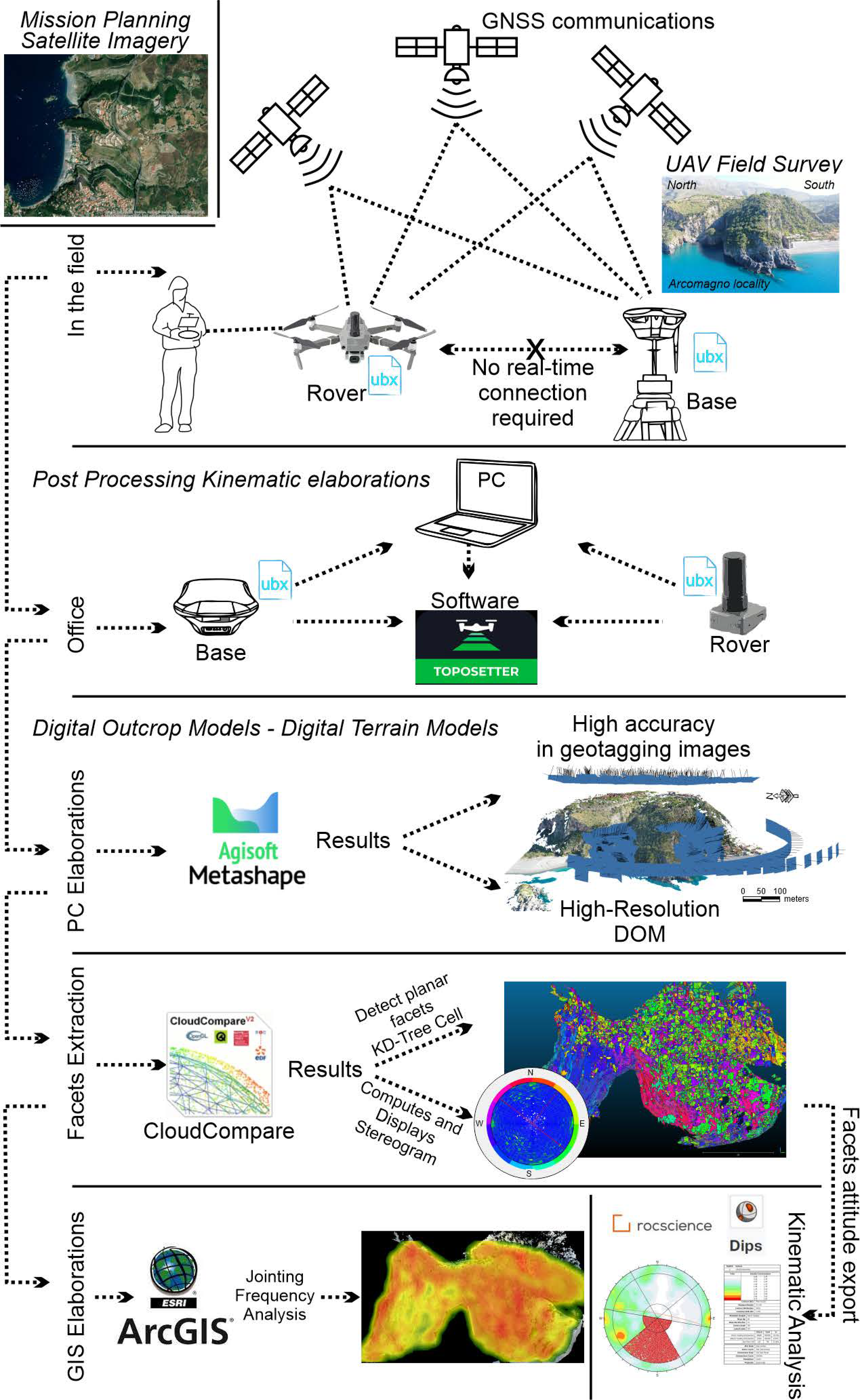



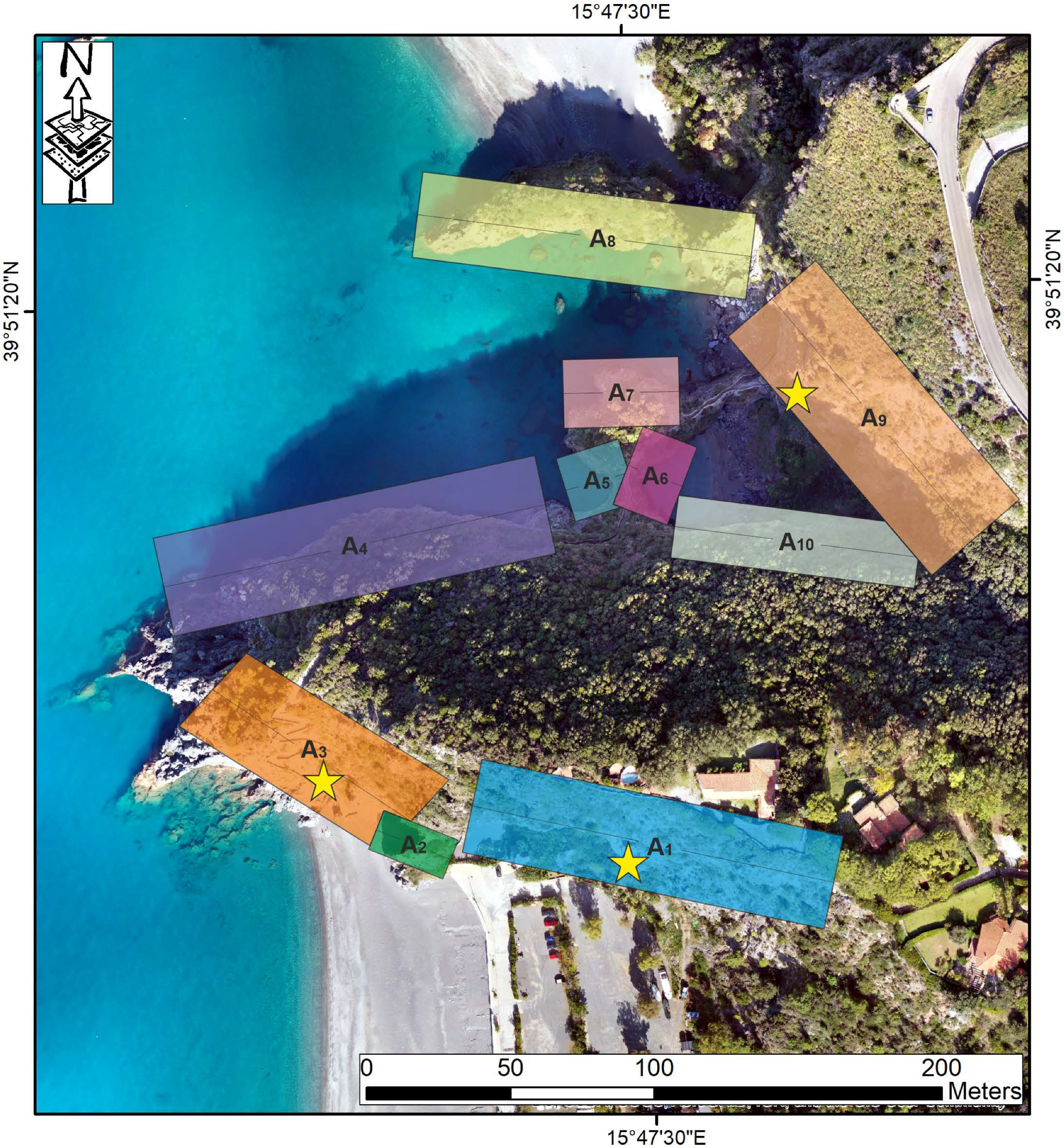
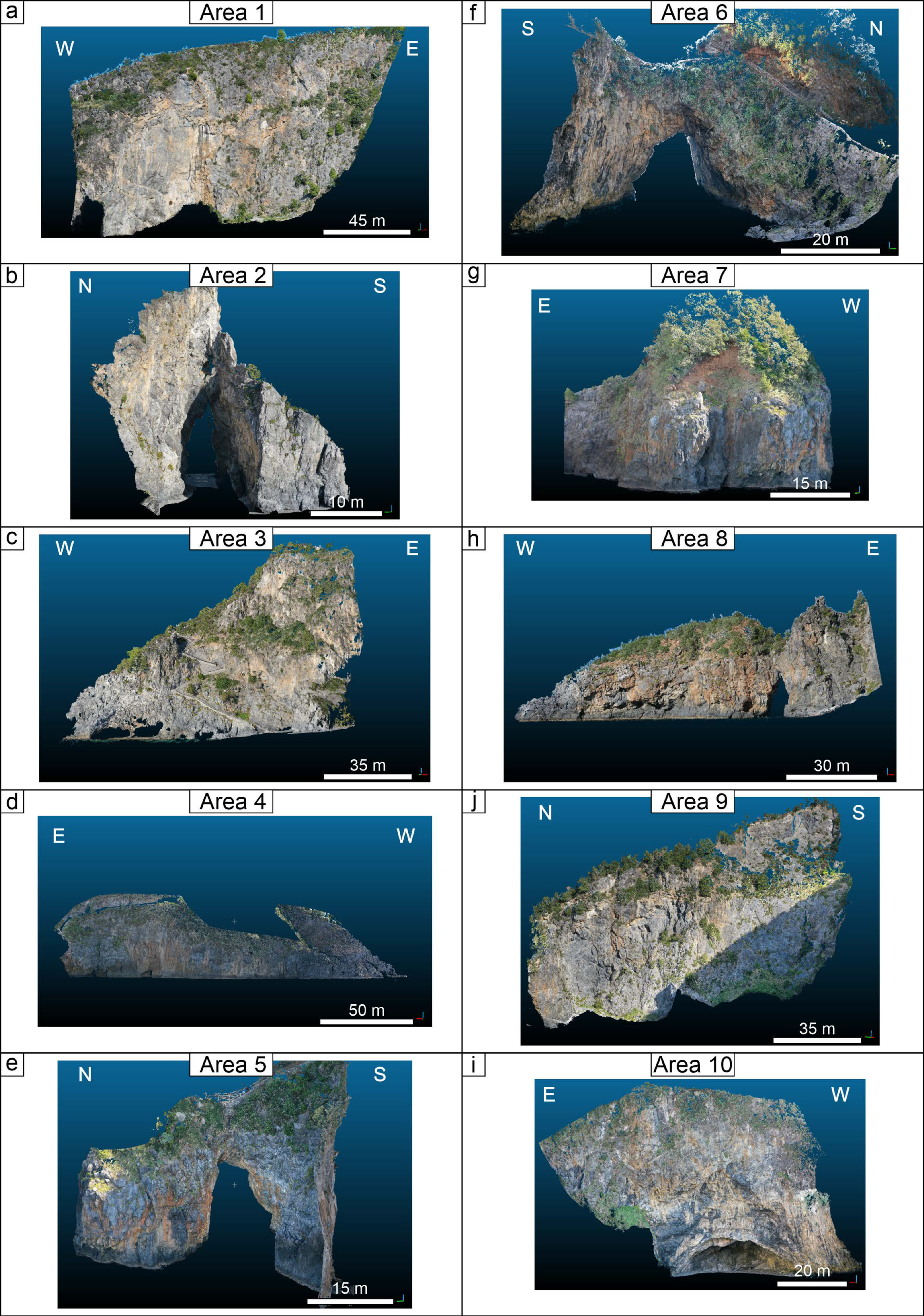
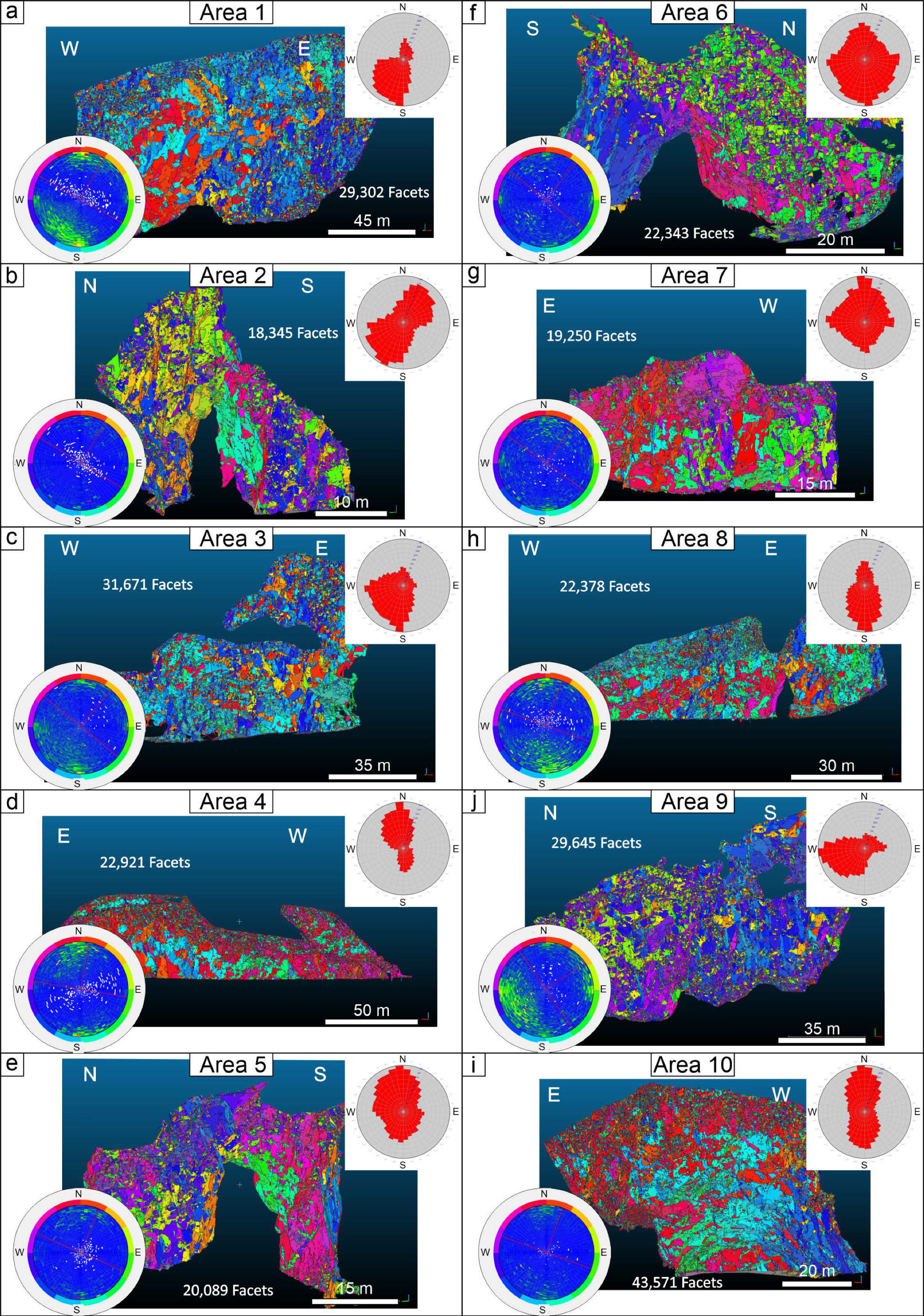
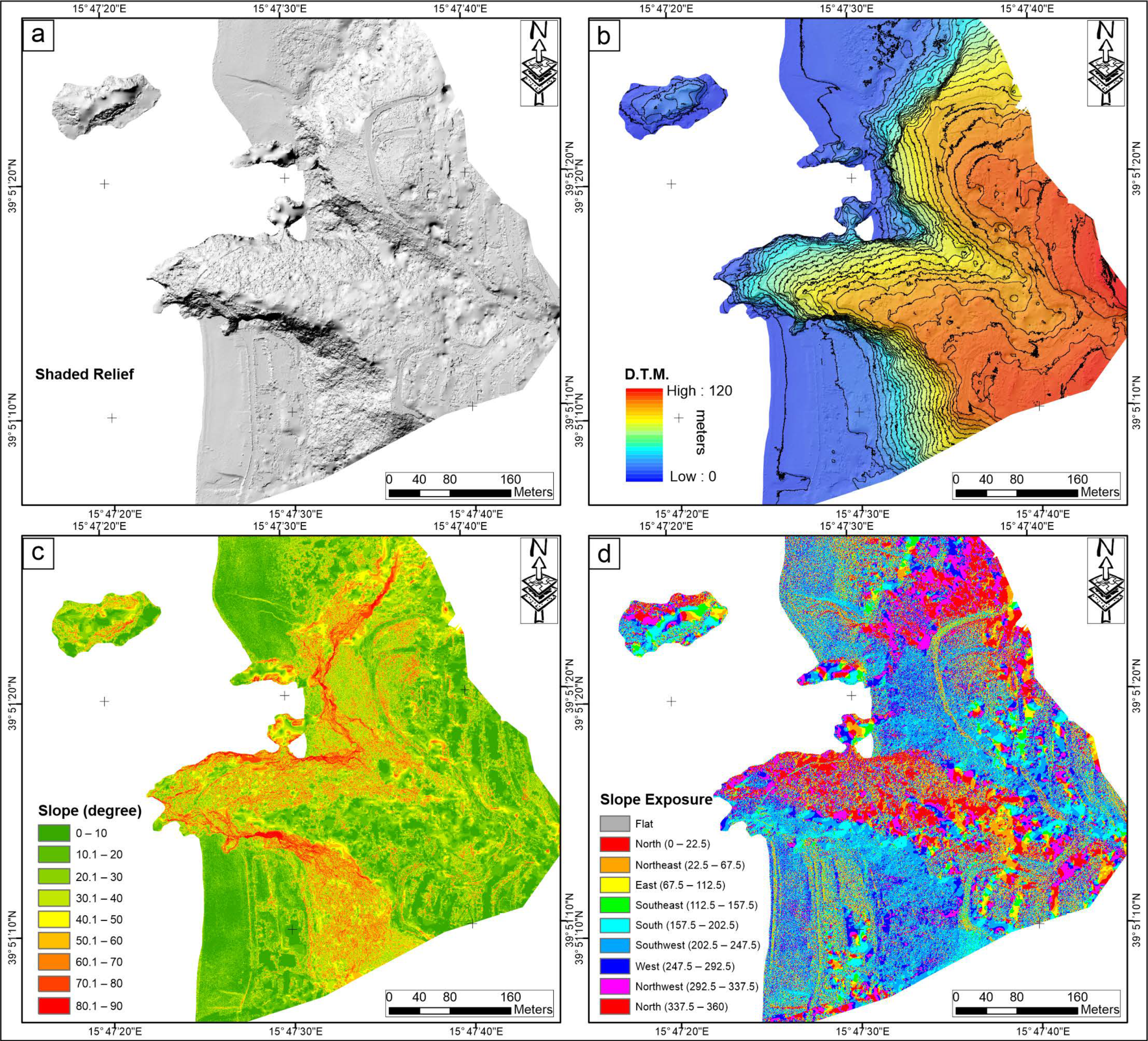
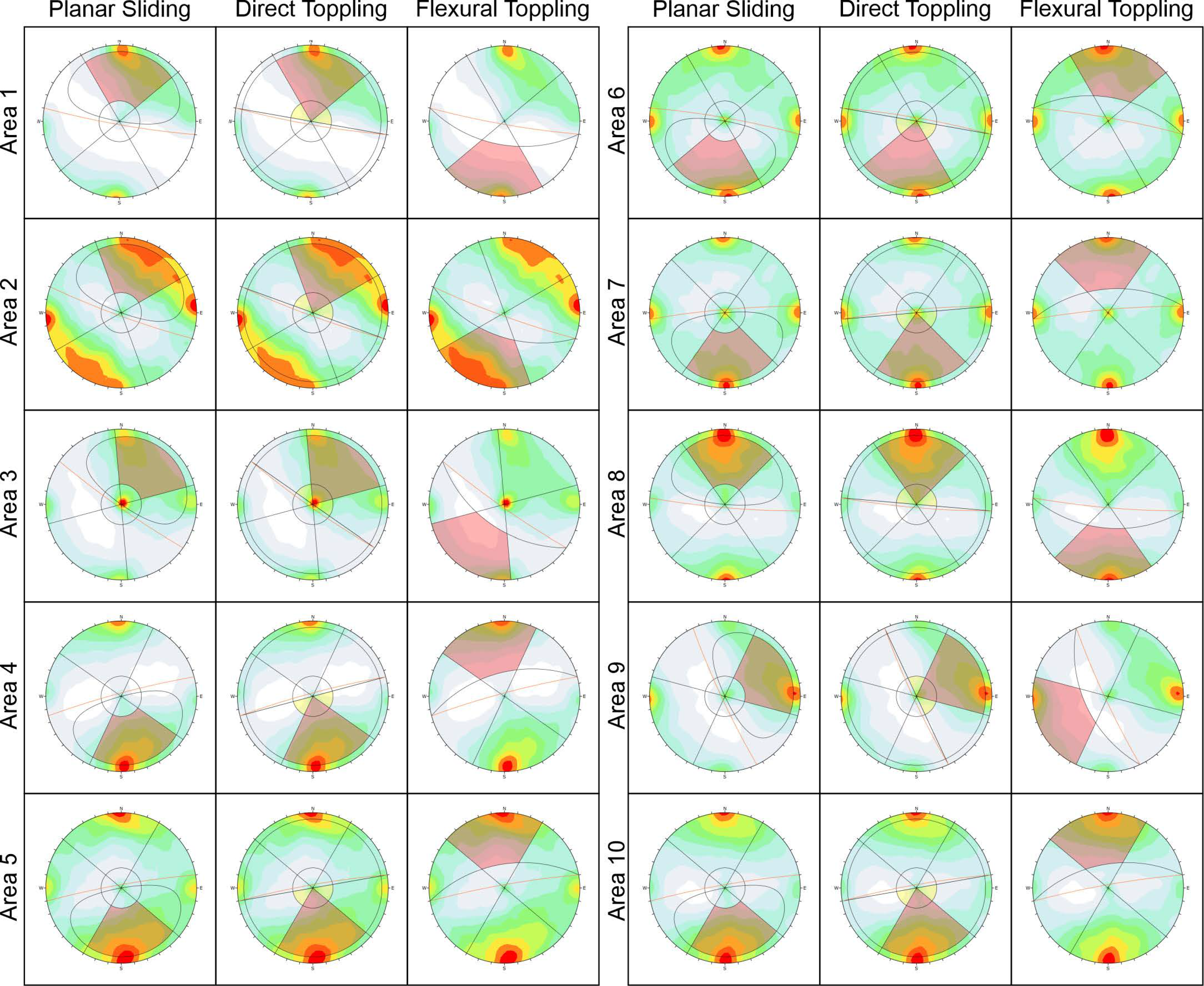
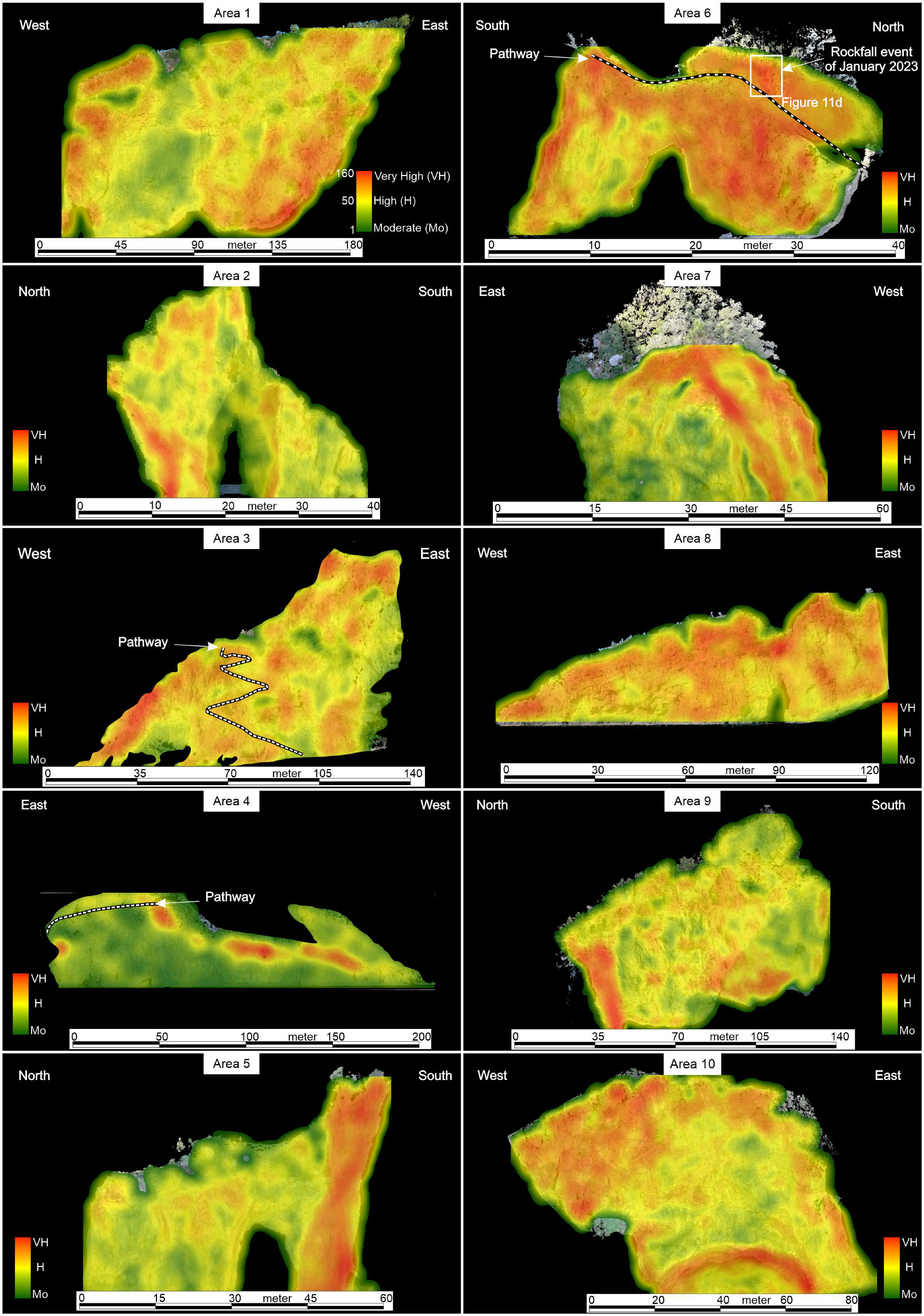
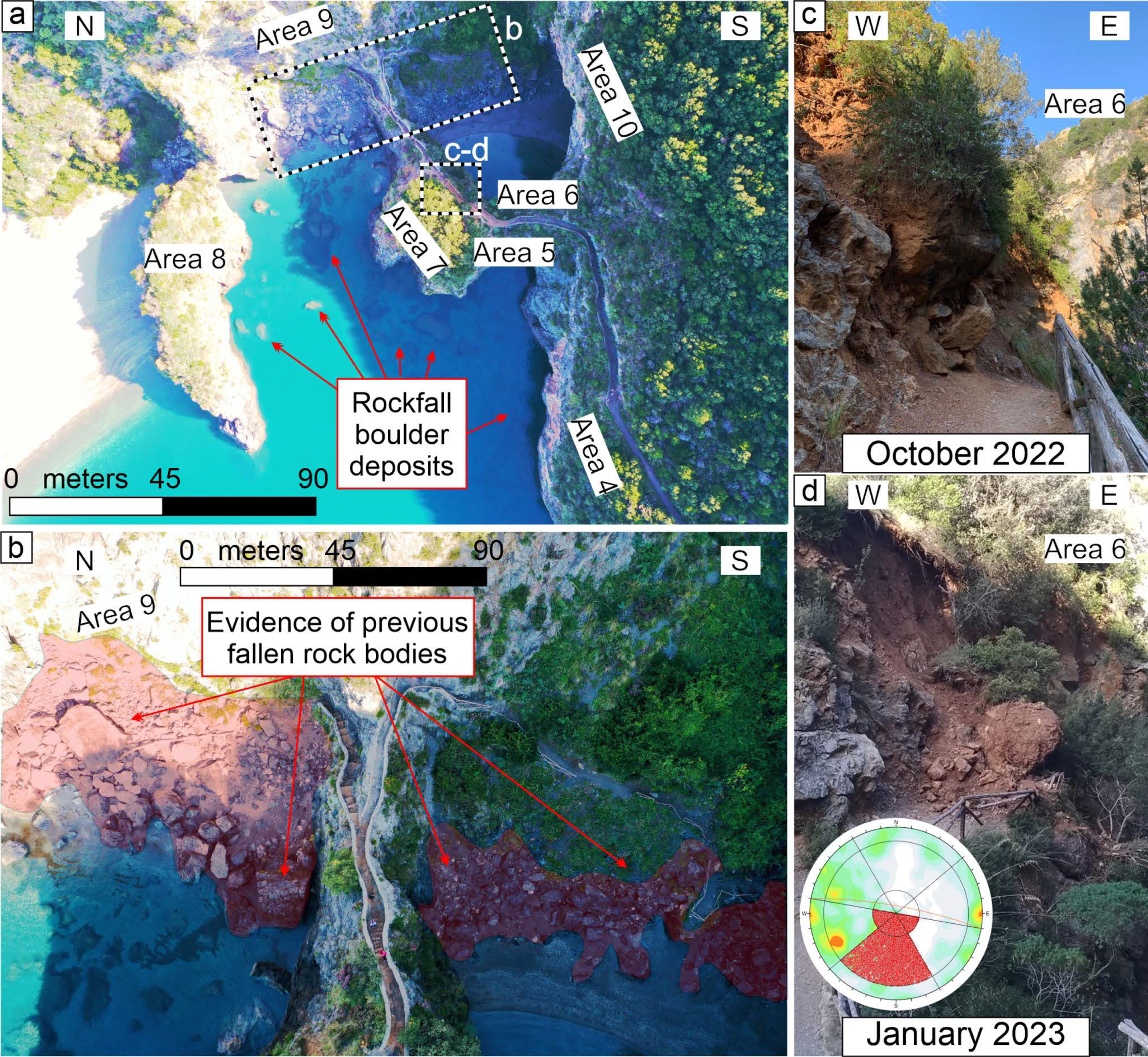

| Mission | UBX GNSS Emlid Reach RS2 YYYY-MM-DD-hh:mm:ss | GNSS Emlid Reach RS2 Coordinate Long | GNSS Emlid Reach RS2 Coordinate Lat | GNSS Emlid Reach RS2 Elevation Z | UBX GNSS Drone (UTC-Time) | Time Start | Time End | N° of Image | Type Flyght |
|---|---|---|---|---|---|---|---|---|---|
| 1 | 2022-10-28-09:28:00 | 15.79284401 | 39.85614727 | 97.884 | 09-38-40 | 11:42 | 11:53 | 175 | Aut. |
| 2 | // | 15.79284401 | 39.85614727 | 97.884 | 10-03-43 | 12:05 | 12:16 | 173 | Aut. |
| 3 | 2022-10-28-10:54:05 | 15.7910236 | 39.85356206 | 5.454 | 10-55-30 | 12:58 | 13:17 | 253 | Man. |
| 4 | 2022-10-28-12:06:54 | 15.79162917 | 39.85499262 | 22.611 | 12-09-53 | 14:11 | 14:29 | 199 | Man. |
| 5 | // | 15.79162917 | 39.85499262 | 22.611 | 12-33-23 | 14:34 | 14:55 | 333 | Man. |
| 6 | // | 15.79162917 | 39.85499262 | 22.611 | 12-57-14 | 14:58 | 15:05 | 79 | Man. |
| 7 | 2022-10-28-13:41:25 | 15.79053023 | 39.85380427 | 1.25 | 13-42-25 | 15:44 | 15:56 | 160 | Man. |
| Mission | Type | Length (m) | Height (m) | GSD (cm/px) | Gimbal (°) | Overlap (%) | Sidelap (%) | Distance Image (m) |
|---|---|---|---|---|---|---|---|---|
| 1 | Double grid | 5695 | 100 | 2.3 | 70 | 60 | 60 | 45 |
| 2 | Single grid | 6103 | 100 | 2.3 | 90 | 70 | 70 | 40 |
| Area | Max Density % | Kinematic Analyses | Slope Dip Direction/Dip | Number of Critical Facets | Number of Total Facets | % |
|---|---|---|---|---|---|---|
| Planar sliding | 10,209 | 34.84 | ||||
| 1 | 4.4 | Direct toppling | N190°/85° | 12,573 | 29,302 | 42.91 |
| Flexural toppling | 4767 | 16.27 | ||||
| Planar sliding | 4357 | 23.75 | ||||
| 2 | 2.42 | Direct toppling | N200°/85° | 5321 | 18,345 | 29.01 |
| Flexural toppling | 4483 | 24.44 | ||||
| Planar sliding | 9187 | 29.01 | ||||
| 3 | 3.44 | Direct toppling | N215°/85° | 13,378 | 31,671 | 42.24 |
| Flexural toppling | 3231 | 10.2 | ||||
| Planar sliding | 7989 | 34.85 | ||||
| 4 | 3.8 | Direct toppling | N345°/85° | 9621 | 22,921 | 41.97 |
| Flexural toppling | 4785 | 20.88 | ||||
| Planar sliding | 5233 | 26.05 | ||||
| 5 | 2.52 | Direct toppling | N350°/85° | 6344 | 20,089 | 31.58 |
| Flexural toppling | 3804 | 18.94 | ||||
| Planar sliding | 3218 | 14.4 | ||||
| 6 | 2.77 | Direct toppling | N010°/85° | 4407 | 22,343 | 19.72 |
| Flexural toppling | 5227 | 23.39 | ||||
| Planar sliding | 4057 | 21.08 | ||||
| 7 | 2.78 | Direct toppling | N355°/85° | 5734 | 19,250 | 29.79 |
| Flexural toppling | 3065 | 15.92 | ||||
| Planar sliding | 7111 | 31.78 | ||||
| 8 | 3.06 | Direct toppling | N185°/85° | 9032 | 22,378 | 40.36 |
| Flexural toppling | 4154 | 18.56 | ||||
| Planar sliding | 9520 | 32.11 | ||||
| 9 | 3.65 | Direct toppling | N245°/85° | 12,269 | 29,645 | 41.39 |
| Flexural toppling | 4652 | 15.69 | ||||
| Planar sliding | 11,790 | 27.06 | ||||
| 10 | 2.88 | Direct toppling | N350°/85° | 14,206 | 43,571 | 32.6 |
| Flexural toppling | 10,821 | 24.84 |
| Very High sq. m. | % | High sq. m. | % | Moderate sq. m. | % | Total Area sq. m. | |
|---|---|---|---|---|---|---|---|
| Area 1 | 2546.7 | 19.3 | 8643.0 | 65.3 | 2036.4 | 15.4 | 13,226.1 |
| Area 2 | 68.4 | 8.9 | 536.3 | 69.9 | 162.3 | 21.2 | 767.0 |
| Area 3 | 1144.4 | 20.4 | 3421.2 | 61.1 | 1032.2 | 18.4 | 5597.8 |
| Area 4 | 337.3 | 5.1 | 1680.2 | 25.5 | 4577.5 | 69.4 | 6595.1 |
| Area 5 | 503.4 | 64.0 | 266.6 | 33.9 | 16.7 | 2.1 | 786.7 |
| Area 6 | 1269.5 | 56.2 | 717.4 | 31.8 | 271.2 | 12.0 | 2258.1 |
| Area 7 | 215.5 | 24.8 | 471.3 | 54.3 | 181.4 | 20.9 | 868.2 |
| Area 8 | 1541.6 | 51.8 | 1237.0 | 41.5 | 199.7 | 6.7 | 2978.3 |
| Area 9 | 920.7 | 14.3 | 3768.7 | 58.7 | 1731.7 | 27.0 | 6421.1 |
| Area 10 | 1041.5 | 30.2 | 1933.5 | 56.0 | 478.9 | 13.9 | 3453.9 |
Disclaimer/Publisher’s Note: The statements, opinions and data contained in all publications are solely those of the individual author(s) and contributor(s) and not of MDPI and/or the editor(s). MDPI and/or the editor(s) disclaim responsibility for any injury to people or property resulting from any ideas, methods, instructions or products referred to in the content. |
© 2024 by the authors. Licensee MDPI, Basel, Switzerland. This article is an open access article distributed under the terms and conditions of the Creative Commons Attribution (CC BY) license (https://creativecommons.org/licenses/by/4.0/).
Share and Cite
Cirillo, D.; Zappa, M.; Tangari, A.C.; Brozzetti, F.; Ietto, F. Rockfall Analysis from UAV-Based Photogrammetry and 3D Models of a Cliff Area. Drones 2024, 8, 31. https://doi.org/10.3390/drones8010031
Cirillo D, Zappa M, Tangari AC, Brozzetti F, Ietto F. Rockfall Analysis from UAV-Based Photogrammetry and 3D Models of a Cliff Area. Drones. 2024; 8(1):31. https://doi.org/10.3390/drones8010031
Chicago/Turabian StyleCirillo, Daniele, Michelangelo Zappa, Anna Chiara Tangari, Francesco Brozzetti, and Fabio Ietto. 2024. "Rockfall Analysis from UAV-Based Photogrammetry and 3D Models of a Cliff Area" Drones 8, no. 1: 31. https://doi.org/10.3390/drones8010031
APA StyleCirillo, D., Zappa, M., Tangari, A. C., Brozzetti, F., & Ietto, F. (2024). Rockfall Analysis from UAV-Based Photogrammetry and 3D Models of a Cliff Area. Drones, 8(1), 31. https://doi.org/10.3390/drones8010031









